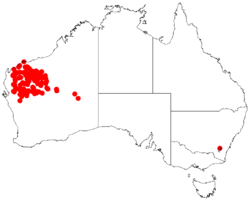Biology:Acacia citrinoviridis
| Black Mulga | |
|---|---|
| Scientific classification | |
| Kingdom: | Plantae |
| Clade: | Tracheophytes |
| Clade: | Angiosperms |
| Clade: | Eudicots |
| Clade: | Rosids |
| Order: | Fabales |
| Family: | Fabaceae |
| Subfamily: | Caesalpinioideae |
| Clade: | Mimosoid clade |
| Genus: | Acacia |
| Species: | A. citrinoviridis
|
| Binomial name | |
| Acacia citrinoviridis Tindale & Maslin
| |

| |
| Occurrence data from AVH | |
Acacia citrinoviridis, commonly known as black mulga, river jam, milhan or wantan,[1] is a tree in the family Fabaceae that is native to western Australia .
Description
Black mulga typically grows to a height of about 5 to 15 metres (16 to 49 ft)[1] and often has a weeping habit.[2] It usually has just one trunk[3] and has grey fissured bark[2] on the trunk and larger branches.[1] Like most Acacia species, it has phyllodes rather than true leaves. These are a grey-olive colour, and may be up to 12 centimetres (4.7 in) long and about 1 centimetre (0.4 in) wide. The flowers are yellow, and held in cylindrical clusters. The pods are around 8 centimetres (3 in) long and have a lemon-green felty covering. From a distance black mulga is similar to mulga but it can be distinguished by its dark bark.
Distribution
The tree is endemic to the Pilbara and northern parts of the Mid West regions of Western Australia, it occurs along creeks and rivers in the semi-arid land north of Carnarvon and Meekatharra where it is often situated in rocky river and creek beds, on stony plains and on rocky ridges growing in stony loam or clay loam, alluvium or red sandy soils.[2]
See also
References
- ↑ 1.0 1.1 1.2 "Acacia citrinoviridis". Flora of Australia Online. Department of the Environment and Heritage, Australian Government. http://www.anbg.gov.au/abrs/online-resources/flora/stddisplay.xsql?pnid=41831.
- ↑ 2.0 2.1 2.2 "Acacia citrinoviridis". FloraBase. Western Australian Government Department of Parks and Wildlife. https://florabase.dpaw.wa.gov.au/browse/profile/3260.
- ↑ Mitchell, A. A.; D. G. Wilco (1994). Arid Shrubland Plants of Western Australia, Second and Enlarged Edition. Nedlands, Western Australia: University of Western Australia Press. ISBN 978-1-875560-22-6.
Wikidata ☰ Q2715232 entry
 |

